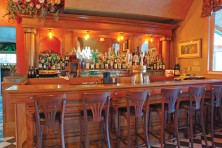Wine Closures with Bryan Bradley of the Mission Grille
- Share
- Tweet
- Pin
- Share
For the last three centuries or so, wine bottles have been traditionally sealed with cork stoppers to prevent oxygen from reacting with the wine. As you may know, natural cork is processed from the bark of the cork tree, which is a type of oak. The majority of the world’s bottle-stopping cork comes from Portugal, where it is a primary export and a key component of the nation’s economy.
As effective as corks have been over the years, they still have their drawbacks. If wine is stored improperly, they can crumble or leak. They can also break easily and worst of all, they can create cork taint which occurs when trichloroanisole (TCA), a compound that forms when a chlorine bleaching agent used in the manufacture of corks, reacts with mold already present in the cork. Wines that are cork tainted will often smell like a wet-dog, or damp basement (it is a mold, after all), and are usually deemed unpalatable.
In an effort to improve quality and wine stability, and eliminate the chances of cork taint, the last 10 years we have seen a steady rise in alternative closures being tried by the wine industry. While synthetic cork, plastics and aluminum screw caps are all being used today, it appears that the screw caps are proving to be possibly even a better alternative to cork when it comes to sealing wine. Leading the way in the screw cap revolution are the winemakers of Australia, New Zealand and France.
The most widely used screw cap closure is the Stelvin® capsule from a French company named Alcan Packaging. These screw cap closures have an aluminum alloy casing as an outer layer with an expanded polyethylene liner. As the cap is compressed, the polyethylene liner compresses and creates an airtight seal, (which is exactly what the cork does). In addition, Stelvin capsules are available with an impermeable liner that is designed for longer-term aging requirements.
For years now, screw cap closures have been relentlessly tested and by all accounts, screw caps have been proven to preserve wine as well or better than cork closures. Add to that the fact that there is no chance of cork taint, and you would think that all winemakers would be in a rush to convert to screw caps. But that is not the case, especially when it comes to wines made in the United States. Here, the screw cap is being adopted much slower than it is by producers like those in New Zealand, where it is almost impossible to find a wine that does not have a screw cap closure.
So why is there so much resistance? As far as we can tell, there is no one single answer to that question. Some winemakers cite the cost of retooling a traditional bottling line as an issue, while others believe that Red wines will not age as well without corks. But as far as we can tell, the real resistance is spurred by the belief among many wine consumers that screw caps are for lower quality, jug wines, and that for fine wines, only cork will do. As it is with wine, only time will really tell…
Alma Rosa Pinot Noir Sta. Rita Hills 2005
“The aromas of this pinot jump right out at you as soon as you remove the screw cap. It is a dark rose/raspberry color with a fair amount of cherry, funk, sweet spice and a bit of cinnamon or clove on the nose. The cherry and sweet spice flavors are up front in the first tastes, then a touch of green pepper accompanied by bright red fruit flavors comes out. On the finish the flavors taper just slightly with some soft and silky tannins coming out. I would say this wine would be a great food wine for quite a number of dishes across the board. First off, I would suggest this with our brie appetizer on the small plates menu with chopped figs, walnuts and citrus marmalade as well as ale braised short ribs with a Vietnamese glaze and red cabbage slaw. As far as entrees, the slow roasted pork shank with red wine veal demi-glaze would be a perfect pairing with the earth and fruit coming through as would the Maple Leaf Farms duck breast with four-berry port wine reduction.”
~ Bryan Bradley, Chef of the Mission Grille (Sister Bay, WI)
Appearance: dark raspberry/rose color
Aroma: big earthy and cherry flavors right away in the aromas with a hint of sweet spice
Flavors: bright red fruit flavors, with a touch of vegetal notes
Finishing Notes: fruit comes through to the end where some soft silky tannins come out
Where to Buy: Main Street Market, Madison Avenue Wine Shop and Top Shelf
Where to Try: The Mission Grille
Information about “Where to Try” and “Where to Buy” these selected wines was provided by the local wine purveyors and vendors. If you happen to also serve or sell these wines, email [email protected].
WINE:30 is written by Karl Bradley and Jody Wuollett. Karl is the general manager and self-proclaimed “sous” sommelier for the Mission Grille. Former restaurant executive and Door County native Jody is happily under-employed as a Mission Grille food server and a member of the local band Northbound.


